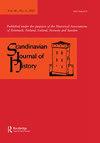契约胁迫:瑞典佃农制度中的土地、劳动和性别
IF 0.8
3区 历史学
Q1 HISTORY
引用次数: 1
摘要
在早期的现代农村环境中,根据土地所有权、社会地位和性别的不同,劳动力受到不同程度的强迫。本文从性别和胁迫的角度分析了以有偿劳动为特征的佃农制度。目的是为了回答这个问题:农家机构是如何被创建、塑造、启用和质疑的。建立家庭的权利使男子有机会担任一家之主,但也增加了社会分层。在签订合同时,佃农是家庭的主人,但在组织劳动时,他们的地位是模糊的。关于身体的完整性,佃农可能受到身体暴力的强迫,并受到与工作无关的规则的约束,例如服从。我认为,这是可以接受的,通过婚姻,并允许无地男子担任一家之主。佃农处于一种中间地位,夹在土地租赁的市场逻辑和强制榨取劳动力的逻辑之间,这一直影响着佃农制度,直到1943年最终解散。本文章由计算机程序翻译,如有差异,请以英文原文为准。
Contracted Coercion: Land, Labour and Gender in the Swedish Crofter Institution
ABSTRACT In the early modern rural setting, labour was organized with varying degrees of coercion depending on landowning, social standing, and gender. This article analyses the crofter institution, characterized by corvée labour (obligatory work as payment), from the perspective of gender and coercion. The purpose is to answer the question of how the crofter institution was created, shaped, enabled and questioned. The right to establish a croft made the position as head of household available for men but it also increased social stratification. While crofters were masters of their households in contract signing, their position was ambiguous when it came to the organization of labour. Regarding physical integrity, crofters could be forced by physical violence and were subject to rules not connected to work, such as subservience. I argue that this was made acceptable through marriage and allowing the position as head of household to landless men. Crofters held an intermediate position, caught between the market logic of leasehold of land and the coercive logic of labour extraction, and this continued to colour the crofter institution until its final dissolution in 1943.
求助全文
通过发布文献求助,成功后即可免费获取论文全文。
去求助
来源期刊

SCANDINAVIAN JOURNAL OF HISTORY
HISTORY-
CiteScore
1.10
自引率
20.00%
发文量
33
期刊介绍:
Scandinavian Journal of History presents articles on Scandinavian history and review essays surveying themes in recent Scandinavian historical research. It concentrates on perspectives of national historical particularities and important long-term and short-term developments. The editorial policy gives particular priority to Scandinavian topics and to efforts of placing Scandinavian developments into a larger context. Studies explicitly comparing Scandinavian processes and phenomena to those in other parts of the world are therefore regarded as particularly important. In addition to publishing articles and review essays, the journal includes short book reviews. Review essay proposals and polemical communications are welcomed.
 求助内容:
求助内容: 应助结果提醒方式:
应助结果提醒方式:


